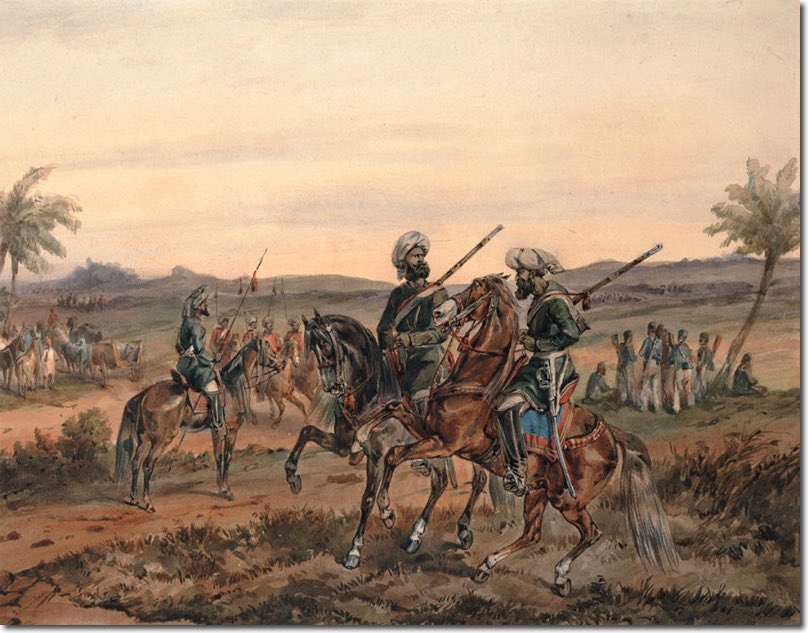
How to get URL link on X (Twitter) App


 Zamindari power was virtually unchanged from 1595 to the annexation of Oudh by Johnny Company in 1858. The establishment and maintenance of it depended heavily upon armed power, as violence is the
Zamindari power was virtually unchanged from 1595 to the annexation of Oudh by Johnny Company in 1858. The establishment and maintenance of it depended heavily upon armed power, as violence is the


 The Indian subcontinent has long been the home of many orders of ascetics, known as sadhus or Sannyasis. Among the most famous of these orders were the Dasnamis, and by the 17th century, its sadhus had become a militarized group, with various bands of armed monks, or Nagas (lit. naked) attached to these sects.
The Indian subcontinent has long been the home of many orders of ascetics, known as sadhus or Sannyasis. Among the most famous of these orders were the Dasnamis, and by the 17th century, its sadhus had become a militarized group, with various bands of armed monks, or Nagas (lit. naked) attached to these sects. 



 tripartite societal organization, led to a weakening of central authority even prior to the decentralization and parcellization of power in the Gupta and post Gupta age, when feudalism properly began in India. The endemic warfare and notions of freedom of this rural aristocracy
tripartite societal organization, led to a weakening of central authority even prior to the decentralization and parcellization of power in the Gupta and post Gupta age, when feudalism properly began in India. The endemic warfare and notions of freedom of this rural aristocracy 

https://twitter.com/biharigurl/status/1775393790746063124


 lifestyles from our grandfathers. Even belonging to the leisure class at the time required considerable walking…so life was more physical in general. My grandfathers belonged to such a class. They would walk/ride everywhere and play Kabaddi for fun…most
lifestyles from our grandfathers. Even belonging to the leisure class at the time required considerable walking…so life was more physical in general. My grandfathers belonged to such a class. They would walk/ride everywhere and play Kabaddi for fun…most

 A cattle raid brought wealth to your community, but also, more importantly, humiliated your rivals. In India, the title of a “cow protector” was an important title with deep significance that did not just relate to protecting cattle from slaughter, but also from raids.
A cattle raid brought wealth to your community, but also, more importantly, humiliated your rivals. In India, the title of a “cow protector” was an important title with deep significance that did not just relate to protecting cattle from slaughter, but also from raids.

 The Cathiar would take up arms for their respective kings. However upon defeat of their liege lord, they could be incorporated into the new kingdom. At times, they entered into political disputes, choosing the kings of the Cheras and Pallavas, or even founded kingdoms
The Cathiar would take up arms for their respective kings. However upon defeat of their liege lord, they could be incorporated into the new kingdom. At times, they entered into political disputes, choosing the kings of the Cheras and Pallavas, or even founded kingdoms 





https://twitter.com/tpeshwa/status/1520627578402480128
 1) Indian clubs. These are fairly famous, even Joe Rogans used one. They are essentially really heavy clubs that are swung. It’s done to make your shoulders stronger. This is similar to the workouts at the Iranian Zoorkhaneh.
1) Indian clubs. These are fairly famous, even Joe Rogans used one. They are essentially really heavy clubs that are swung. It’s done to make your shoulders stronger. This is similar to the workouts at the Iranian Zoorkhaneh.

 and poetry and seek to hide/burn it(example is Gandhi). The other side seems to portray the past as some sort of an orgy which only ended when the Muslims arrived. They point to sculptural evidence, but ofc cannot explain some of the more absurd sculptures.
and poetry and seek to hide/burn it(example is Gandhi). The other side seems to portray the past as some sort of an orgy which only ended when the Muslims arrived. They point to sculptural evidence, but ofc cannot explain some of the more absurd sculptures. 

 It sounds crazy, but could you imagine a father giving his daughter away to an impotent shithead with no markers of success or virility? So now that we have established that whatever society we live in, selection of some sort will be there, we can attempt to interpret the graph.
It sounds crazy, but could you imagine a father giving his daughter away to an impotent shithead with no markers of success or virility? So now that we have established that whatever society we live in, selection of some sort will be there, we can attempt to interpret the graph.
